The Vishera Review: AMD FX-8350, FX-8320, FX-6300 and FX-4300 Tested
by Anand Lal Shimpi on October 23, 2012 12:00 AM ESTGaming Performance
Our latest discrete GPU gaming tests use a GeForce GTX 680, while the older tests use the Radeon HD 5870. We're focused on looking at differences between CPUs here so most of the numbers you see are CPU bound rather than pushing the GPU to the limits. As most games are at best a mixture of single and lightly multithreaded workloads, AMD's FX platform doesn't do well here at all. If you're looking to build a high end gaming machine and want the best CPU for the job, Vishera isn't it.
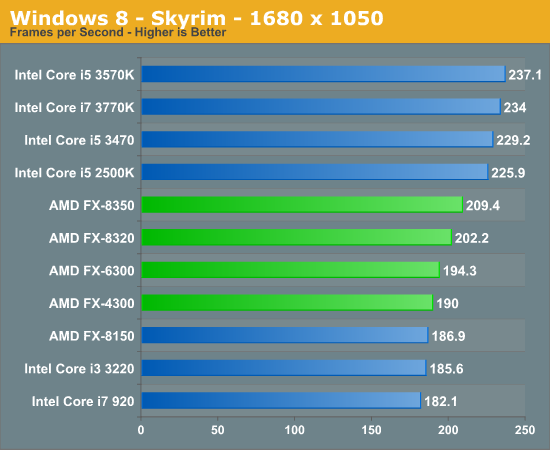

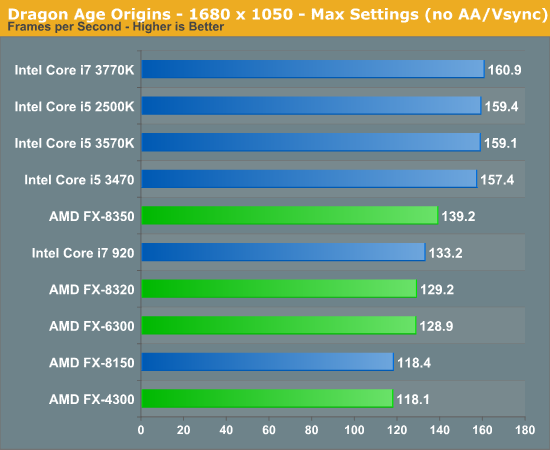
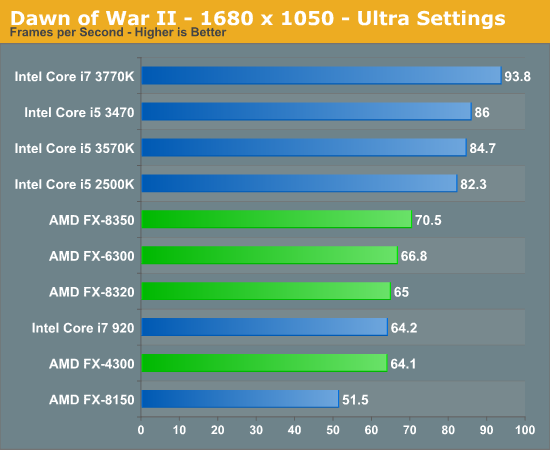
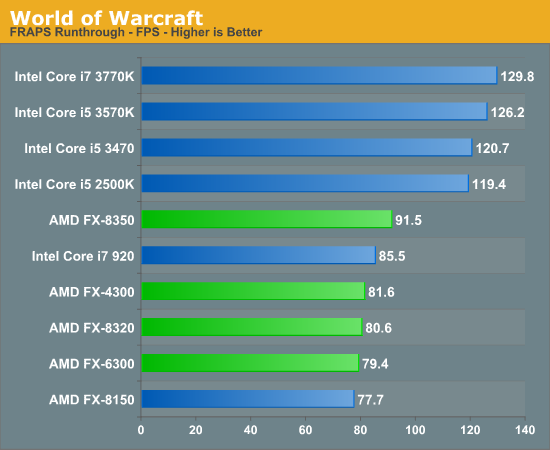
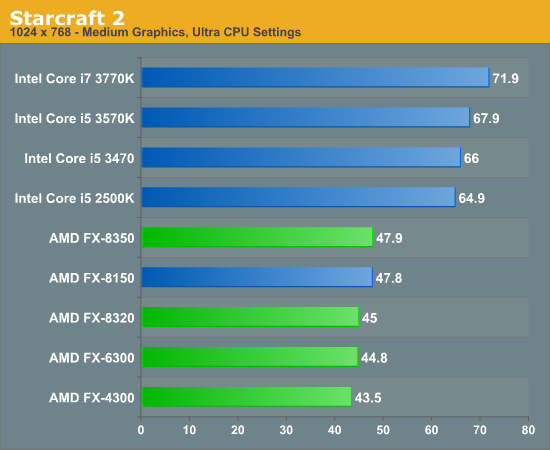










250 Comments
View All Comments
A5 - Tuesday, October 23, 2012 - link
The gaming benchmarks contain exactly 0 FPS games. You should really read the article before commenting.kevith - Tuesday, October 23, 2012 - link
I could eat a dictionary and SHIT a better comment than that.CeriseCogburn - Tuesday, October 30, 2012 - link
" The FX-8350 did immensely better in that gaming selection. Mostl gamers are not shoot-em-up fascist gamers. "LOL - wrong again, but your lefty whine was extremely amusing. Most gamers are shoot em up gamers, YOU LIAR.
GullLars - Tuesday, October 23, 2012 - link
What they didn't show you is what happens when you OC the K parts from intel. They end up roughly in the same TDP as AMD on stock, and just crush them on performance, so if you are going to use the same aftermarket cooler and will overclock either pick, the Intel parts can go further and win across the board.Compared to the cost of an entire system ~$100-150 extra on the CPU for a 3770K might end up being around a 10% increase in total build cost, and giving you anywhere from 10 to 50% better performance (or more in some corner cases).
I'm happy with my OC'd 3930K :D (compared to to the rest of my equipment, the price was no problem)
Probably upgrading my C2D 2.0GHz + 8600GTM laptop to a Haswell with only IGP in 2013. With an SSD and RAM upgrade it has had surprisingly good longevity.
CeriseCogburn - Tuesday, October 30, 2012 - link
Exactly, all the amd cpu unlockers, all the dang phenom 2 overlcockers - totally silent.The 2500K smoke sit up to 4500mhz like butter, but heck, when something is freaking GREAT and it's not in amd's advantage, it's memory hole time, it's ignore it completely after barely mentioning it, and just as often continue to declare it an unused and unliked and proprietary failure that holds everyone back - whatever can be done to lie and skew and spin.
It's just amazing isn't it.
eanazag - Tuesday, October 23, 2012 - link
I had pretty low expectations admittedly and for good reason. This is a great step because I would have to think platform vs. platform where before I didn't even need to consider it. Intel has a huge thermal advantage, which indicates that Intel could easily come out with a proc at anytime to take advantage of that headroom should AMD ever become slightly threatening, and sadly still be below performance per Watt. I could reasonably consider AMD now for my desktop. Where AMD fails is at the platform level. They have underperformed in the motherboard department. If they wanted to sell more, they need to give serious advantages at the motherboard + CPU purchase level versus Intel. They have been fine with a mediocre chipset. They failed when they locked out Nvidia from chipset development, same with Intel. AMD and Intel's greed was a big loss for the consumer and part of the reason why AMD doesn't compete well with Intel. Nvidia made better chipsets for AMD than AMDs ATI chipset development team.It is even worse on the server side for AMD. AMD needs to include 10GbE on the board to really question Intel and this is doable. AMD cannot compete on process (22nm and 3D transistors) unless Intel closed shop for 18 months.
CeriseCogburn - Tuesday, October 30, 2012 - link
LOL - thank you so much.Yes, the hatred for nVidia (and Intel) cost the amd fanboys dearly, but they really, really, really enjoyed it when nVidia chipsets got shut down.
nVidia was going to be destroyed then shortly thereafter according to them, and thus we heard a couple years of it from their freaking pieholes - amd would drop the price and knife nVidia into oblivion... and bankrupcty... cause amd has a "lot more room" to price drop and still rake in profit... they said... LOL - as they whined about nVidia being greedy and making so much money.
Yes, they were, and are, nutso.
Oh the party days they had... now they have CRAP. LOL
Ken g6 - Tuesday, October 23, 2012 - link
Anand, I think you missed a diamond in the rough here for gaming. Obviously, if someone has the money for an i5, they should get an i5. But if they don't, the FX-4300 looks like a better gaming choice than an i3. There are cheap mobos available, so overall cost is less than an i3, and the FX-4300 is overclockable. OCed it may even approach low-end i5 performance - at a power cost, of course.tekphnx - Tuesday, October 23, 2012 - link
For only $10 more I'd say the FX-6300 is the better bet. Slightly lower clock speed but still overclockable, and I don't think it will be that long before six cores become really relevant for gaming.lmcd - Tuesday, October 23, 2012 - link
Worst case you can probably disable a core and OC more, right?